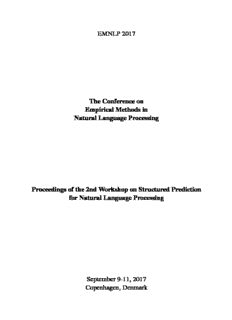Table Of ContentEMNLP 2017
The Conference on
Empirical Methods in
Natural Language Processing
Proceedings of the 2nd Workshop on Structured Prediction
for Natural Language Processing
September 9-11, 2017
Copenhagen, Denmark
(cid:13)c 2017TheAssociationforComputationalLinguistics
OrdercopiesofthisandotherACLproceedingsfrom:
AssociationforComputationalLinguistics(ACL)
209N.EighthStreet
Stroudsburg,PA18360
USA
Tel: +1-570-476-8006
Fax: +1-570-476-0860
[email protected]
ISBN978-1-945626-93-7
ii
Introduction
WelcometotheSecondworkshoponstructuredpredictionforNLP!
Many prediction tasks in NLP involve assigning values to mutually dependent variables. For example,
when designing a model to automatically perform linguistic analysis of a sentence or a document
(e.g., parsing, semantic role labeling, or discourse analysis), it is crucial to model the correlations
betweenlabels. ManyotherNLPtasks,suchasmachinetranslation,textualentailment,andinformation
extraction,canbealsomodeledasstructuredpredictionproblems.
Inordertotacklesuchproblems,variousstructuredpredictionapproacheshavebeenproposed,andtheir
effectiveness has been demonstrated. Studying structured prediction is interesting from both NLP and
machine learning (ML) perspectives. From the NLP perspective, syntax and semantics of the natural
language are clearly structured and advances in this area will enable researchers to understand the
linguisticstructureofdata. FromtheMLperspective,alargeamountofavailabletextdataandcomplex
linguistic structures bring challenges to the learning community. Designing expressive yet tractable
modelsandstudyingefficientlearningandinferencealgorithmsbecomeimportantissues.
Recently, there has been significant interest in non-standard structured prediction approaches that take
advantage of non-linearity, latent components, and/or approximate inference in both the NLP and
ML communities. Researchers have also been discussing the intersection between deep learning and
structuredpredictionthroughtheDeepStructurereadinggroup. Thisworkshopintendstobringtogether
NLPandMLresearchersworkingondiverseaspectsofstructuredpredictionandexposetheparticipants
torecentprogressinthisarea.
This year we have eight papers covering various aspects of structured prediction, including neural
networks, deep structured prediction, and imitation learning. We also invited four fantastic speakers.
Wehopeyouallenjoytheprogram!
Finally, we would like to thank all programming committee members, speakers, and authors. We are
lookingforwardtoseeingyouinCopenhagen.
iii
Organizers:
Kai-WeiChang,UCLA
Ming-WeiChang,MicrosoftResearch
AlexanderRush,HarvardUniversity
VivekSrikumar,UniversityofUtah
ProgramCommittee:
AmirGloberson,TelAvivUniversity(Israel)
AlexanderSchwing(UIUC)
IvanTitov(UniversityofAmsterdam)
JanardhanRaoDoppa(WSU)
JasonEisner(JHU)
KarlStratos(TTIC)
KevinGimpel(TTIC)
LukeZettlemoyer(UW)
MattGormley(CMU)
MohitBansal(UNC)
MoYu(IBM)
NoahSmith(UW)
ParisaKordjamshidi(TulaneUniversity)
RaquelUrtasun(UniversityofToronto)
RoiReichart(Technion)
OferMeshi(Google)
ScottYih(Microsoft)
ShayCohen(UniversityofEdinburgh)
ShuohangWang(SingaporeManagementUniversity)
WaleedAmmar(AI2)
YoavArtzi(Cornell)
v
Table of Contents
DependencyParsingwithDilatedIteratedGraphCNNs
EmmaStrubellandAndrewMcCallum .................................................... 1
EntityIdentificationasMultitasking
KarlStratos.............................................................................7
TowardsNeuralMachineTranslationwithLatentTreeAttention
JamesBradburyandRichardSocher......................................................12
StructuredPredictionviaLearningtoSearchunderBanditFeedback
AmrSharafandHalDauméIII...........................................................17
SyntaxAwareLSTMmodelforSemanticRoleLabeling
FengQian,LeiSha,BaobaoChang,LuChenLiuandMingZhang...........................27
SpatialLanguageUnderstandingwithMultimodalGraphsusingDeclarativeLearningbasedProgram-
ming
ParisaKordjamshidi,TaherRahgooyandUmarManzoor...................................33
Boosting Information Extraction Systems with Character-level Neural Networks and Free Noisy Super-
vision
PhilippMeerkampandZhengyiZhou.....................................................44
PiecewiseLatentVariablesforNeuralVariationalTextProcessing
IulianVladSerban,AlexanderOrorbiaII,JoellePineauandAaronCourville.................52
vii
Conference Program
Thursday,September7,2016
9:00–10:30 Section1
9:00–9:15 Welcome
Organizers
9:15–10:00 InvitedTalk
10:00–10:30 DependencyParsingwithDilatedIteratedGraphCNNs
EmmaStrubellandAndrewMcCallum
10:30–11:00 CoffeeBreak
11:00–12:15 Section2
11:00–11:45 InvitedTalk
11:45–12:15 PosterMadness
12:15–14:00 Lunch
ix
Thursday,September7,2016(continued)
14:00–15:30 Section3
14:00–14:45 PosterSession
EntityIdentificationasMultitasking
KarlStratos
TowardsNeuralMachineTranslationwithLatentTreeAttention
JamesBradburyandRichardSocher
StructuredPredictionviaLearningtoSearchunderBanditFeedback
AmrSharafandHalDauméIII
SyntaxAwareLSTMmodelforSemanticRoleLabeling
FengQian,LeiSha,BaobaoChang,LuChenLiuandMingZhang
Spatial Language Understanding with Multimodal Graphs using Declarative
LearningbasedProgramming
ParisaKordjamshidi,TaherRahgooyandUmarManzoor
Boosting Information Extraction Systems with Character-level Neural Networks
andFreeNoisySupervision
PhilippMeerkampandZhengyiZhou
14:45–15:30 InvitedTalk
15:30–16:00 CoffeeBreak
x
Description:cс2017 The Association for Computational Linguistics. Order copies of this and other ACL proceedings from: Association for Computational Linguistics (ACL). 209 N. Eighth Street. Stroudsburg, PA 18360. USA. Tel: +1-570-476-8006. Fax: +1-570-476-0860
[email protected]. ISBN 978-1-945626-93-7.

